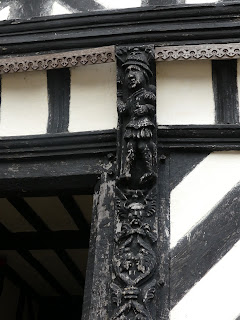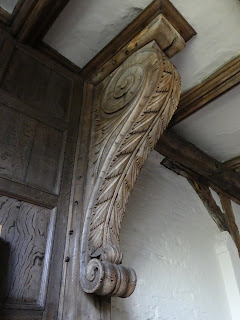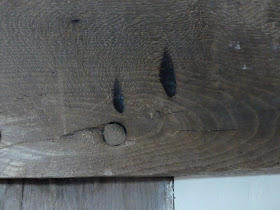A record of wildlife in my garden and various trips to the Warwickshire countryside and occasionally further afield.
Thursday, 7 November 2019
A Visit to Little Moreton Hall, Cheshire
Little Moreton Hall is one of those places that you often see pictured in magazines and it has been on my list of places to visit for years and years. My son took one look at photos of the place recently and was keen to go too so we visited last weekend.
Sadly, the M6 this time lived up to its reputation and we were stuck in a traffic jam for an hour or more so we ended up only having 2 hours to explore the Hall.
As you walk from the car park towards the hall in the distance you can see the ruins of Mow Cop Castle.
*D
*D
Little Moreton hall was built to impress with its expensive glazed windows and towering chimneys showing the craftsmanship of Tudor times - glazing, carpentry, plasterwork and paintings are all a visual delight. Throughout its history the hall has been owned by one family the Moretons until they gave it to the National Trust in 1938. It is a moated, half timbered framed hall and building began in 1503/4 and finished in 1610.
Since the 13th century the Moretons had been important landlords and may have increased their wealth by buying land available after the Black Death of 1348 struck and during The Dissolution of the Monasteries 1536 - 1541. The income from their lands (1,360 acres) enabled them to build Little Moreton Hall over a period of 100 years - gradually extending and improving it up until the Civil War in 1642. During the Civil War they were on the side of the Royalists and this meant that when the Parliamentarian Government ruled the country the hall began to decline. The construction of the hall was due to four successive Moretons - three called William and one called John.
Following the Civil War the Hall was rented out for 200 years to relatives and then tenant farmers.
*D
Hallowtide in Tudor Times was a festival lasting 3 days and included Halloween or All Hallow's Eve on 31st October, All Saints on 1st November and All Souls the following night. There were quite a few activities for children at the hall taking place and we did listen to a few ghost stories.
*D
Halloween or Hallowtide has its origins in the Celtic Festival of Samhain The origins of trick or treating stem from "souling" or "soul caking" when poor children would go from house to house to recite or sing a souling rhyme and in return for a spiced soul cake they would promise to pray for the dead of the family. In "mumming" people would dress in frightening clothes and masks to keep the spirits of the dead at bay. Jack o' Lanterns were made from hollowed out turnips or swedes and a lighted candle would be placed inside. This represented a soul trapped in purgatory and would scare away evil spirits. Today we carve pumpkins to make lanterns. Apples were sacred to the Celts and apple games were played at the Festival of Samhain. The Roman Festival of Pomona on 1st November was dedicated to the goddess of fruits and today we eat toffee apples and perhaps play apple bobbing.
*D
There were some beautiful carvings around a door near the Gatehouse which included a warrior - they reminded me of those seen at Stokesay Castle earlier this year.
*D
*D
The interior of the house is as impressive as the exterior.
*D
The Great Parlour
"The great rounde table" was mentioned in 16th century inventories. Some of the stained glass dates from the 16th century too and the wolf from the Moreton's family crest can be seen.
The fireplace shows Queen Elizabeth I's coat of arms.
The Great Hall which is one of the oldest parts of the building dating from 1544-8.
One of the bedchambers on the first floor - by this stage I was getting a trifle confused as to which room we were in!
*D
*D
Timothy was enjoying himself immensely :)
Witch Protection Marks - D bought me a book on the "Mysterious Marks" of Little Moreton Hall but as we left so I missed most of the carvings.
During a recent survey 256 burn marks were found around Little Moreton Hall.In addition to burn marks 2 other marks were discovered - one a compass drawn design with circles and arcs and the other composed of triangles. Further research has shown that the Hall has 3 of the recognised types of "protection marks" i.e. burns, circles and "witch webs". From the location of the burn marks around the house it would appear they were placed at locations where evil could enter i.e. around doors, windows and fireplaces.
Right at the top of the house is The Long Gallery with its painted plasterwork and sloping floor.
The Gallery Chamber
Plasterwork over the fireplace demonstrates Protestant values with Justice and her scales and Prudence with an open book. The central panel contains the Moreton Arms quarterd by the cross of the Macclesfield family to celebrate the marriage between John de Moreton and Margaret Macclesfield in 1329. Mythical sea creatures can also be seen.
The wall paintings in the Little Parlour were created in the late 1500's and they again demonstrate the growth of Protestanism in England. They were re-discovered in 1876 hidden under wooden panelling.
The Chapel is 500 years old and services are still held every Sunday
Decorative 16th century tiles.
16th century wall paintings and biblical text.
*D
The Knot Garden
Corn store
*D
*D
*D
*D
*D
*D
We had a look round the shop before leaving as
*D
the sun was setting.
*D
Two hours wasn't really long enough but we did explore most of the hall and garden. Little Moreton Hall has joined the list of "places to re-visit" :)
*D Photos taken by my son with the Canon SX50 bridge camera
Rest of photos taken by me with the Panasonic Lumix FZ330 bridge camera
Reference:
Information boards around the Hall
National Trust Guide Book to Little Moreton Hall
"Mysterious Marks at Little Moreton Hall" by Barbara Jackon and Jill Owen



















































































Certainly built to impress in its day, and still impressive today. What a building! I have always observed Hallowtide, not just Hallowe'en, and my church does an All Soul's service where you can give the names of family you wish to be remembered in the special service. I wonder if carving a pumpkin became so popular when America was colonised? I can't imagine them having Swede or turnip, and pumpkins would have been plentiful so a natural substitute, then made it's way back to Britain when Hallowe'en became popular here again. I remember Mum telling me her childhood memories of a hollowed out turnip. How painfully hard that must have been to scoop out! No wonder pumpkins are so popular, and they can be hard enough too. Lovely to see Timothy again, he has been missed lately.
ReplyDeleteRustic Pumpkin - Thanks so much and it is an amazing building. My son not normally keen on NT properties thought it was brilliant. Yes I remember when my father died we went to the All Soul's Service at the church and lit a candle.
ReplyDeleteI suspect you are right about pumpkins and America. Bad enough chopping swede or turnip for a casserole let alone scooping out and carving as you say :) My son has uploaded a kindle book on the history of Halloween so will ask him about pumpkins.
Sorry Timothy has not been around so much recently - he has been with me but I've not always had time to get him out of my bag and pose.
I'm so glad you got to visit Little Moreton, it's one of my favourite places and we will hopefully visit again for their Christmas Festivities and events with Piva, always a highlight. The peacock on the round table in the great parlour is new since our last visit, I've not seen it before. The M6 is a nightmare isn't it? Earlier in the week there was an accident between Stafford and Stoke, there seems to be something happening somewhere along it quite often from reports I see on the local news. Glad to see Timothy in his warm winter woolies, it gets a bit nippy in the hall at this time of year:)
ReplyDeleteRosie - Thanks so much. I remember seeing the Hall on your blog and it was another spur to visit so thank you. We went past the turn coming back from Alderley Edge and I mentioned then going to my son. I look forward to your Christmas posts on it. I think the peacock was called Patrick!! Just loathe the M6 - I think earlier there had been a broken down vehicle and an accident on the bit where they are installing the dreaded "smart motorway" and lanes are closed anyway. Signs on the M6 suggested an eleven minute delay not an hour!!! Fortunately traffic not so bad on return journey!
ReplyDeleteWhat a wonderful looking hall! We used to carve swedes as kids for Halloween and always attached string so we could carry them about!
ReplyDeletePam - Thanks so much and it was a rather magical hall :) So interesting to read about your turnip lanterns and the string is a clever idea :)
ReplyDeleteit's a fascinating building pleased you got there!
ReplyDeleteThe Quacks of Life - Thanks so much Pete - I had high expectations but it exceeded them!! :)
ReplyDeleteI love this hall, your photos are wonderful :-)
ReplyDeleteCherryPie - Thanks so much :)
ReplyDelete